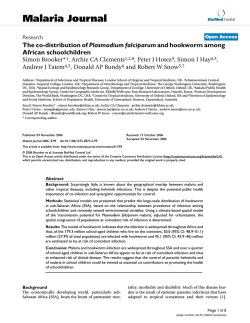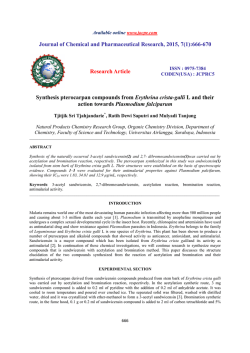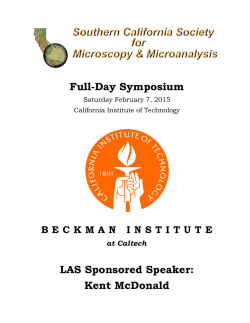
Download PDF - NIHR-DEC - National Institute for Health Research
Diagnostic Evidence Co-operative Oxford Cooperative Oxford HR Diagnostics Evidence Cooperative Oxford Point-of-care tests for malaria Horizon Scan Report 0040 January 2015 Clinical Question: In the primary care setting, what is the accuracy and utility of malaria point-of-care (POC) tests in the detection of parasitaemia caused by Plasmodium species, compared to standard laboratory practice using Microscopy and/or Polymerase Chain Reaction (PCR)? Background, Current Practice and Advantages over Existing Technology: Background: Malaria is an important infectious disease, caused by the protozoan Plasmodium and transmitted by inoculation with an infected Anopheles mosquito. A variety of Plasmodium species cause malaria, typically producing cyclical systemic symptoms including fever, headache, vomiting and lethargy. Infection with Plasmodium falciparum can result in severe disease, and can lead to neurological sequelae including cerebral malaria and at worst death. The World Health Organisation (WHO) World Malaria Report of 2009 estimates 243 million cases of malaria worldwide in 2008, the majority of which (85%) occurred in Africa, followed by South-East Asia (10%) and then the Eastern Mediterranean (4%).(1) Whilst the largest burden of disease rests in Africa, the burden of malaria is increasing in nonendemic, industrialized areas due to imported disease in returning travellers who have no immunity (2 ). Many travellers do not comply with use of appropriate chemoprophylaxis and insect protection measures (3). For the reasons outlined above, malaria is an important differential diagnosis in febrile patients who have travelled to malaria endemic regions. Current Practice and Advantages over Existing Technology: a) Primary care assessment of patients with suspected malaria Existing Technology: Patient is clinically reviewed by General Practitioner (GP) and if malaria is suspected, liaison takes place with Infectious Diseases Registrar/medical registrar, with subsequent assessment of the patient in an Infectious Diseases Unit or appropriate Medical Assessment Unit. It is unlikely that blood samples would be sent from General Practice, due to the time delay that this would incur. However, were this to take place, blood samples would be sent from General Practice to the local hospital laboratory for analysis of thick and thin blood films for Plasmodium forms. Results would typically be sent back to the GP within NIHR Diagnostic Evidence Cooperative Oxford www.oxford.dec.nihr.ac.uk 24 hours. Depending on the significance of the result, this may or may not need to be relayed to the Infectious Diseases Registrar and hospital admission planned. Benefits of malaria POC testing: Rapid (within minutes) positive or negative malaria result, expediting referral to the Infectious Diseases team if positive, and investigation of other causes of febrile illness if negative without referral to the Infectious Diseases team. This technology could therefore allow assessment to move from a secondary care setting to primary care. This may lower testing thresholds. b) Secondary care assessment of patients with suspected malaria Existing Technology: Patients with suspected malaria in secondary care are frequently managed on Infectious Diseases wards and have an EDTA blood sample taken and analysed in the hospital laboratory. Here, the specimen is analysed under a microscope for Plasmodium forms. A diagnosis and/or level of parasitaemia is then estimated and appropriate treatment commenced if necessary. Other tests, such as PCR, may also be employed as a reference test. Benefits of malaria POC testing: Rapid (within minutes) result of malaria infection, allowing prompt initiation of appropriate treatment. POC tests can be used in conjunction with microscopy, the latter helping to identify the specific Plasmodium species so as to direct treatment. Details of Technology: Malaria POC tests are generally portable, hand-held devices, the majority of which employ lateralflow immunochromatography to detect Plasmodium antigens in a finger-prick sample of blood. A positive or negative result can be generated in as little as 10 minutes, allowing rapid diagnosis or exclusion of malaria. Their rapidity and also simplicity of use, not requiring specialist knowledge or equipment, are seen as their principle advantages over the current gold standard of laboratory based microscopy of thick and thin blood films. Malaria POC tests can be grouped largely on the basis of the Plasmodium antigen detected. Some tests detect histidine-rich protein (HRP-2), which is solely produced by Plasmodium falciparum. Other tests detect aldolase, which is common to all Plasmodium species and therefore pan-specific. Yet other tests detect parasite lactate dehydrogenase enzymes (pLDH), which can be pan-specific, targeting a conserved pLDH element found in all Plasmodium species, or specific to particular Plasmodium species, targeting species unique regions of pLDH. A summary of available point-of-care malaria tests we identified can be found in the table in Appendix 1. Patient Group and Use: 1) Ruling out malaria in travellers returning from malaria endemic regions with febrile illness. 2) Ruling out malaria in patients visiting the UK from malaria endemic regions presenting unwell to primary and/or secondary care. Importance: Light microscopy is considered the gold standard for malaria diagnosis (4). However, microscopic diagnosis of malaria requires time, trained personnel, and adequate laboratory facilities. In many parts of rural Africa in which malaria is most prevalent, access to such services is difficult or simply not possible. As such, there has been considerable interest in developing a new technology that could be used to rapidly diagnose malaria by non-skilled personnel (5). Despite the burden of malaria being considerably less in the United Kingdom, there were 1501 cases of malaria in the UK in 2013 and 7 deaths (6). Prompt diagnosis and treatment of malaria could reduce morbidity and mortality. In the primary care setting, laboratory microscopic analysis of blood films is not possible. Implementation of a reliable malaria POC device could facilitate primary care diagnosis of malaria, allowing faster referral to secondary care, and more rapid administration of potentially life-saving treatment where appropriate. Previous Research: Accuracy compared to existing technology Given the topical nature of malaria POC tests, a vast number of studies have examined their accuracy and potential utility. Below, we have focussed on the data from pertinent meta-analyses and other relevant studies. POC tests in malaria endemic regions A 2011 Cochrane review (7) analysed the use of POC tests in detecting clinical Plasmodium falciparum malaria in patients presenting to ambulatory healthcare centres in malaria endemic regions. The reference standard was defined as falciparum parasitaemia detected on microscopy, in conjunction with symptoms suggestive of malaria. Data from 74 studies described in 79 study reports were analysed. The POC tests were divided into seven different categories (‘Type 1 tests’ through to ‘Type 7 tests’) dependent on the test target antigen. The vast majority of tests evaluated were ‘Type 1 tests’ evaluating HRP-2 specific POC tests. The authors identified 71 evaluations, in which 10 different brands of Type 1 POC tests had been verified with microscopy, encompassing 40,062 individuals. The sensitivities of the tests ranged from 42% to 100%, with specificities between 65% and 100%. The meta-analytical average sensitivity and specificity (95% confidence interval (CI)) were 94.8% (93.1% to 96.1%) and 95.2% (93.2% to 96.7%) respectively. Comparison of the 10 POC test brands analysed did not reveal statistically significant differences (p=0.18), however, substantial heterogeneity between studies was apparent. There were 17 evaluations of ‘Type 4’ POC tests (identifying both Plasmodium falciparum specific and pan-specific pLDH antigens) verified with microscopy. The meta-analytical average sensitivity and specificity (95% CI) were 91.5% (84.7% to 95.3%) and 98.7% (96.9% to 99.5%), respectively. Upon comparison of the four brands of POC tests used in the type 4 tests evaluations, statistically significant (P=0.009) differences were noted. More precisely, Carestart Malaria Pf/Pan was found be more sensitive but less specific than OptiMAL, OptiMAL-IT and Parabank (sensitivity of 97.8% compared with 90.1%, 87.4% and 87.9%, respectively; specificity of 92.2% compared with 99.3%, 97.0% and 98.8%, respectively). Statistical comparison was made between ‘Type 1’ and ‘Type 4’ tests with significant differences in test accuracy noted (p = 0.009). ‘Type 4’ tests were found to have a significantly higher specificity (p<0.001) than ‘Type 1’ tests in the comparisons based on all data, however, no significant difference was found between the sensitivity of these tests (p=0.34). The lower specificity of Type 1 tests may be due to the use of HRP-2 antibodies, which can give a false positive result in successfully treated cases of Plasmodium falciparum malaria, due to persistent antigenaemia. Thus, the choice of which test to employ in clinical practice would depend upon the prevalence of malaria in the affected region and additionally the goal of the test. In primary care, the intention would be to exclude malaria, and as such a test with high sensitivity would be desirable. Conversely, a highly specific test might be required in a secondary care setting to aid decisions regarding initiation of treatment. A meta-analysis (4) examined the role of only the Parasight-F POC test (which had also been included in the Cochrane review) in the detection of falciparum malaria. 32 studies from 29 publications were evaluated, comprising 15,359 comprising 15,359 resident and non-resident subjects in a variety of malaria endemic and non-endemic countries. The included studies compared Parasight F against microscopy as a reference standard. Parasight-F demonstrated an overall meta-analytical sensitivity of 90.9% and specificity of 94.3%. The authors conclude that Parasight-F is a valid diagnostic tool that could be used stand-alone or in conjunction with microscopy. However, for any test it is important to recognise that the utility of the test is highly dependent upon the prevalence of malaria in a geographical region. Based on the pooled sensitivity and specificity data, in a region of 60% P. falciparum prevalence, the positive predictive value (PPV) would be 96%, with a negative predictive value (NPV) of 87%. However, in a region of 10% P. falciparum prevalence, the PPV would be much lower at 64%, conversely, the NPV would be 98%. POC tests in Pregnancy Plasmodium falciparum infection during pregnancy can result in severe illness and at worst death of mother and foetus (8). In pregnant women malarial parasites express an antigenic variant allowing them to sequester in the placenta, known as placental malaria, rendering microscopic diagnosis of peripheral blood inadequate (9). Placental histology is therefore the gold standard for diagnosis of placental malaria. However, placental analysis is only possible after delivery, and as such examination of peripheral blood during pregnancy is current standard practice. A meta-analysis of 49 studies was performed to assess the accuracy of POC tests and PCR in diagnosis of malaria in pregnancy (10). Microscopic analysis of peripheral and placental blood was used as a reference standard, with the latter deemed the more accurate reference standard. The sensitivity (proportion of microscopy positives in placental blood) detected by POC tests was 81%, versus 72% for peripheral blood microscopy and 94% for PCR analysis. The specificity (proportion of placental blood microscopy negative women) detected by POC tests was 94%, against 98% for peripheral blood microscopy and 77% for PCR. POC tests in Non-immune travellers to malaria endemic regions A meta-analysis (2) analysed the accuracy of POC tests in diagnosing malaria in non-immune travellers returning from malaria endemic countries, predominantly in Africa, Asia and South/Central America. Twenty-one studies were included, encompassing 5747 patients; eighteen of these studies were performed at regional or national tropical disease centres. The use of HRP-2 based tests and pLDH based tests was compared against microscopy and/or PCR as gold standards. Both two-band (detecting Plasmodium falciparum only) and three-band (detecting Plasmodium falciparum as well as Plasmodium malariae, Plasmodium ovale and Plasmodium vivax) HRP-2 tests were included in the analysis. Studies in which more than 10% of individuals were immune were excluded. The negative likelihood ratio (LR-) was predefined as the primary measure of accuracy. This metaanalysis found that HRP-2 tests were statistically significantly more accurate than p-LDH based tests at ruling out Plasmodium falciparum, with LR-s of 0.08 and 0.13 respectively (p=0.019 for difference). For Plasmodium vivax, there was no statistically significant difference between the LRfor three band HRP-2 tests compared to parasite LDH tests (LR-s of 0.24 and 0.13 respectively; p=0.22), however, the available studies upon which these figures were based were few and heterogeneous in nature. The authors conclude that POC tests are a useful to rule out malaria when negative, but they should be used in conjunction with microscopy for species identification and confirmation when positive. Summary POC tests appear to be an accurate alternative compared to traditional microscopic analysis of blood films for malarial parasites. POC tests detecting HRP-2 antigens appear to have a higher sensitivity but lower specificity than POC tests detecting p-LDH. As such, the choice of which POC test to employ would largely depend upon the prevalence of malaria in the region of interest and the intended goal of the test. Given that the UK is a non-endemic region largely dealing with malaria in travellers and immigrants from endemic regions, and the aim of any rapid test would be to rule out. It is difficult to specify an optimal time-frame within which POC tests should be used given the varying incubation periods of Plasmodium species; in addition, latent blood infection with Plasmodium parasites can persist for years. Impact compared to existing technology A Cochrane meta-analysis (11) reviewed the utility of POC tests versus clinical diagnosis (relying on symptomatology and clinical signs alone) of malaria in febrile patients in rural African endemic settings, with a view to assessing whether this would reduce inappropriate use of anti-malarial drugs in patients with febrile illness not caused by malaria. Seven trials were reviewed, consisting of 17,505 febrile patients. Overall, POC tests did not reduce the number of unwell patients at day 4-7 post treatment; in those diagnosed with POC tests 2.8% to 9.3% remained unwell, versus a range of 4.1% to 10.8% remaining unwell in the clinically diagnosed group (Relative risk [RR[ = 0.90, 95% CI 0.69-1.17). Prescribing outcomes were very variable with high inter-study heterogeneity (I²=98%); in one trial in Burkina Faso (12) 81% of patients with negative POC test results were prescribed anti-malarial drugs. As such, in this study and two others in which there was low adherence to prescribing in line with POC test results, no significant difference in anti-malarial prescribing was found between treatment groups (Risk ratio 0.90, 95% CI 0.68-1.20). However, in the four trials in which health workers adherence to prescribing in line with POC test results was high, a large reduction in anti-malarial prescribing was found, with a risk ratio of 0.44 (95% CI 0.29-0.67). The safety of withholding anti-malarial drugs in patients with negative POC test results has been questioned (13). As afore-mentioned, in high prevalence areas of malaria transmission, a negative test result might carry a high false negative rate (4), meaning that some patients with malaria might be missed and therefore not treated on the basis of an inaccurate POC test result. As highlighted by the practice of healthcare workers in the study by Bisoffi et al (12), a POC test result may not necessarily lead to a change in practice if the clinical suspicions of the medical practitioner are different to the POC test result. Whilst the UK has a low prevalence of malaria, faced with a very unwell febrile patient with suspected malaria and a negative POC test, one might envisage empiric anti-malarial treatment being given until the definitive laboratory microscopic analysis result is available. A prospective study was undertaken to determine the feasibility of non-immune travellers to Kenya between June 1998 and February 1999 to self-diagnose malaria using POC tests (14). Patients with fever (T>38 degrees Celsius) were asked to use an HRP-2 detecting POC test (ICT Malaria Pf) with assistance only from the device’s accompanying manual and no prior training. A thick blood film was also performed on each patient. Of 98 patients with fever, only 67 (68%) were able to obtain a result. Of the 11 patients that had microscopically confirmed falciparum malaria, only one was able to produce a valid test result. Of those failing to obtain a test result, 87% cited that they were unable to interpret their test result, and 71% cited that they were unable to draw sufficient fingerprick blood for analysis. This would suggest that use of POC tests should be carried out by healthcare professionals, or at least those who have had basic training in their use. In summary, malaria POC tests have the potential to reduce inappropriate use of anti-malarials in endemic regions, bypassing the time and expertise required for microscopic analysis. POC tests may also have a role in diagnosis of placental malaria. However, due to the possibility of obtaining a false negative result, the action taken in light of a negative result is likely to depend upon the prevalence of malaria in the region of use and the beliefs held by the clinician interpreting the result. Malaria POC tests should be used by healthcare professionals or those with adequate training in their use and interpretation. Guidelines and Recommendations: In the WHO guidelines for the treatment of malaria, it is stipulated that prompt confirmation of malarial parasite infection using microscopy or alternatively POC tests is advised in all patients with suspected malaria, prior to initiation of anti-malarial treatment (15). Whilst in the UK access to microscopic diagnostics is readily available, in parts of rural Africa POC tests could be a giant step in the direction toward making the WHO edict a reality. The guidelines for Malaria prevention in travellers from the UK, produced by Public Health England (PHE) (16), state that POC tests may be useful in the hands of medical personnel accompanying an expedition to a malaria endemic region, but not for self-diagnosis by lay people. Furthermore, this guidance cautions that in the UK POC tests are not a substitute for microscopy, but they may be used alongside blood films for diagnostic purposes. Research Questions: 1) Trials in the primary care setting to help determine whether POC tests are a viable means of ruling out malaria, and hence improve targeted referral to secondary care when appropriate, as opposed to current practice of relying upon clinical suspicion. 2) Assessment of the cost:benefit ratio of implementing use of POC tests within primary care. Suggested next steps: 1) Studies to determine the needs in different clinical situations and settings within primary care, e.g. urgent care/out-of-hours. 2) Studies to assess the utility and feasibility of training patients travelling to rural malaria endemic regions in use of malaria POC tests. Expected outcomes: The use of POC tests in diagnosis of malaria would be expected to lead to faster diagnosis of malaria in suspected cases, and therefore faster initiation of treatment for those affected. Conversely, prompt acquisition of a negative test result could help reduce inappropriate prescription of antimalarial drugs, with consequent reduction of the morbidity that can be associated with adverse drug reactions, the ever-increasing problem of drug resistance, as well as reduction of the financial burden stemming from drug wastage. A negative test result should empower the clinician to investigate alternative differentials for febrile illness. References: 1. World Health Organization.World Malaria Report 2009.Geneva: World Health Organization, 2009. 2. Marx, A., D. Pewsner, M. Egger, R. Nuesch, H.C. Bucher, B. Genton, C. Hatz, and P. Juni, Meta-analysis: accuracy of rapid tests for malaria in travelers returning from endemic areas. Annals of Internal Medicine, 2005. 142(10): p. 836-46. 3. Kain KC, Harrington MA, Tennyson S, Keystone JS. Imported malaria: prospective analysis of problems in diagnosis and management. Clin Infect Dis. 1998;27: 142-9. 4. Cruciani, M., S. Nardi, M. Malena, O. Bosco, G. Serpelloni, and C. Mengoli, Systematic review of the accuracy of the ParaSight-F test in the diagnosis of Plasmodium falciparum malaria. Medical Science Monitor, 2004. 10(7): p. MT81-8. 5. Point of Care Malaria Infection Detection Test. For Rapid detection of low-density, subclinical malaria infections http://sites.path.org/dx/files/2012/11/DIAMETER_IDT_TPP_FINAL_forwebsite.pdf 6. PHE Malaria Reference Laboratory; http://www.hpa.org.uk/web/HPAweb&HPAwebStandard/HPAweb_C/1195733773780 7. Abba, K., J.J. Deeks, P. Olliaro, C.M. Naing, S.M. Jackson, Y. Takwoingi, S. Donegan, and P. Garner, Rapid diagnostic tests for diagnosing uncomplicated P. falciparum malaria in endemic countries. Cochrane Database Syst Rev, 2011(7): p. CD008122. 8. Desai M, ter Juile FO, Nosten F, McGready R, Asamoa K, Brabin B, Newman RD: Epidemiology and burden of malaria In pregnancy. Lancet Infect Dis 2007, 7:93-104. 9. Rogerson SJ, Hviid L, Duffy PE, Leke RF, Taylor DW: Malaria in Pregnancy:pathogenesis and immunity. Lancet Infect Dis 2007, 7:105-117. 10. Kattenberg JH, Ochodo EA, Boer KR, Schallig HD, Mens PF, Leeflang MM. Systematic review and metaanalysis: rapid diagnostic tests versus placental histology, microscopy and PCR for malaria in pregnant women. Malaria Journal, 2011. 10: p. 321. 11. Odaga,J., D. Sinclair, J.A. Lokong, S. Donegan, H. Hopkins, and P.Garner, Rapid Diagnostic tests versus clinical diagnosis for managing people with fever in malaria endemic settings. Cochrane Database Syst Rev, 2014. 4: p. CD008998. 12. Bisoffi Z, Sirima BS, Angheben A, Lodesani C, Gobbi F,Tinto H, et al. Rapid malaria diagnostic tests vs. clinical management of malaria in rural Burkina Faso: Safety and effect on clinical decisions. A randomized trial. Tropical Medicine & International Health 2009;14(5):491–8. 13. English M, Reyburn H, Goodman C, Snow RW. Abandoning presumptive malaria treatment to laboratoryconfirmed diagnosis and treatment in African children with fever. PLoS Med 2009;6:e252. 14. Jelinek T, Amsler L, Grobusch MP, Bothdurft HD. Self-use of rapid tests for malaria diagnosis by tourists. Lancet 1999; 354:1609. 15. World Health Orgnaisation. Guidelines for the treatment of malaria. Guidelines for the treatment of nd malaria (2 edition). Geneva: World Health Organisation, 2010. 16. Public Health England. Guidelines for Malaria Prevention in travellers from the UK 2014. July 2014. Acknowledgements: The authors would like to thank Nia Roberts for helpful discussions. This work is supported by the National Institute for Health Research (NIHR) Diagnostic Evidence Co-operative Oxford at Oxford Health NHS Foundation Trust. The views expressed are those of the authors and not necessarily those of the NHS, the NIHR or the Department of Health. This report was prepared by the Primary Care Diagnostic Horizon Scanning Centre Oxford Authors: Oghenekome Gbinigie, Ann Van den Bruel, Christopher P. Price, Carl Heneghan, Annette Plüddemann Contact details: Dr. Annette Plüddemann; Email: [email protected] Diagnostic Evidence Co-operative Oxford Appendix 1: Table of available point-of-care malaria devices Cooperative Oxford HR Diagnostics Product Manufacturer/ Blood Sample Analysis Location type Volume Time Evidence Cooperative Oxford Paracheck-Pf ParaSight - F ICT Malaria Pf/pv ICT Malaria PF Rapid Malaria Pf/Pv CareStart Malaria Pf/Pan Parabank Orchid Biomedical Systems; India Becton Dickinson; Franklin Lakes, NJ, USA Amrad-ICT Diagnostics; Sydney, Australia ICT Diagnostics; New South Wales, Australia Accu-tell; New Delhi, India CE Mark FDA approved Portable Detection Range/Limit (parasites/ μl) Positive result outcomes P. falciparum Storage Temp. (Degrees Celsius) 4-45 Method Principle Antigen detected analysed (μl) Capillary Whole Blood Capillary Whole blood 5 μl 20 mins Yes No Yes Unknown 50 μl Unknown Unkn own No Yes >100 parasites P. falciparum per microliter Unknown Immunochromato- PfHRP-2 graphic Assay Unknown 10 μl Unknown Unkn own No Yes Unknown 2-30 Immunochromato- Aldolase graphic Assay and PfHRP-2 Capillary Whole blood/ven ous Capillary Whole blood/Ven ous 5 μl 15 mins Yes No Yes > 200 parasites/ P. falciparum μl 4-40 Immunochromato- PfHRP-2 graphic Assay 10 μl 15 mins Yes No Yes Unknown 2-30 Immunochromato- PfHRP-2 graphic Assay and P.vivax pLDH No Yes Unknown 4-30 Immunochromato- PfHRP-2 graphic Assay and PanpLDH No Yes Unknown 4-30 Immunochromato- Pangraphic Assay pLDH Access Bio; New Jersey, USA Capillary Whole blood 5 μl 20-30 mins Zephyr Biomedicals; Verna, India Capillary Whole blood 5 μl 20 mins Yes NIHR Diagnostic Evidence Cooperative Oxford www.oxford.dec.nihr.ac.uk 1) P. falciparum 2) Mixed infection 1) P. falciparum 2) P. vivax 3) Mixed P.falciparum and P. vivax 1) P. falciparum malaria or mixed 2) Nonfalciparum malaria Pan-specific Immunochromato- PfHRP-2 graphic Assay ParaHIT-F BinaxNOW Malaria Test MAKROmed Malaria Test Visitect Malaria Pf Span Diagnostics Ltd; Surat, India Alere; Maine, USA Capillary Whole blood Capillary Whole blood/ven ous blood 5 μl 15 mins Unkn own No Yes >100 μl P. falciparum 4-40 Immunochromato- PfHRP-2 graphic Assay 15 μl 15 minutes Yes Yes Yes 1)P. falciparum/ mixed 2) Non-falciparum malaria 2-37 Immunochromato- PfHRP-2 graphic Assay and aldolase MACROmed manufacturing, LTD; South Africa Omega Diagnostics LTD Capillary Whole blood Unknown <20 mins Unkn own No Unknown >310/ μl for P.falciparum >50/ μl for nonfalciparum spp >100 μl P. falciparum Unknown Immunochromato- PfHRP-2 graphic Assay Capillary Whole blood/Ven ous blood Capillary Whole blood/Ven ous blood 5 μl 15 minutes Yes No Yes Unknown P. falciparum 4-40 Immunochromato- PfHRP-2 graphic Assay 5 μl 15 minutes Yes No Yes Unknown 4-30 Immunochromato- Pan pLDH graphic Assay and PfHRP- 2 Capillary Whole blood 10 μl 20 minutes Yes No Yes >50-100/ μl 2-30 Immunochromato- pLDH graphic Assay (P.falciparum specific) and pLDH (panspecific) Immunochromato- pLDH graphic Assay (P.falciparum specific) and pLDH (panspecific) Enzyme-linked PfHRP-2 Immunosorbent Assay Visitect Malaria Combo Pan/Pf Omega Diagnostics LTD DiaMed OptiMAL-IT BIO-RAD; California, USA 1) P. falciparum or mixed 2) Nonfalciparum malaria 1) P. falciparum malaria or mixed 2) Nonfalciparum malaria OptiMAL DiaMed AG, Cressier, Switzerland Capillary Whole blood Unknown 20 minutes Yes No Unknown Unknown Malaria-Ag CELISA Cellabs, Australia Capillary Whole blood or 100 μl 2 hours Yes No No >5-50 / μl 1) P. falciparum malaria or mixed 2) Nonfalciparum malaria P. falciparum Unknown 2-8 Malascan Zephyr Biomedicals; Verna, India PATH Falciparum Malaria IC test Determine Malaria Pf PATH; Seattle, USA serum Capillary Whole Blood 5 μl 20 minutes Yes No Yes Unknown Capillary whole blood 5 μl Unknown Unkn own No Yes Abbott Laboratories; Tokyo, Japan Acumen Diagnostics Inc; USA HUMAN Diagnostics, Germany (Capillary Whole blood) Capillary Whole Blood Capillary or venous whole blood 2 μl 30 minutes Unkn own No 10 μl 10 minutes Unkn own 5 μl 15 minutes SD Malaria Antigen Bioline SD Diagnostics; Korea Capillary Whole Blood 5 μl Parascreen Rapid Test for Malaria Pan/Pf Zephyr Biomedical Systems; Verna, India Capillary Whole blood First Response Malaria (pLDH/HRP2 combo test) Premier Medical Corporation; Daman, India Whole blood DiaSpot Malaria Hexagon Malaria Immunochromato- PfHRP2 graphic Assay and aldolase >100 μl 1) P. falciparum/ 4-30 mixed 2) Nonfalciparum malaria P. falciparum Unknown Yes Unknown P. falciparum Unknown Immunochromato- PfHRP-2 graphic Assay No Yes Unknown P. falciparum Unknown Immunochromato- PfHRP-2 graphic Assay Yes No Yes Unknown 2-30 Immunochromato- PfHRP2 graphic Assay and aldolase 15-30 minutes Yes No Yes >50/ μl 1-40 Immunochromato- PfHRP-2 graphic Assay and panpLDH 5 μl 20 minutes Yes No Yes Unknown 4-30 Immunochromato- PfHRP-2 graphic Assay and panpLDH 5 μl <20 minutes Yes No Yes >200/ μl 1-40 Immunochromato- PfHRP-2 graphic Assay and panpLDH 1) P. falciparum/ mixed 2) Nonfalciparum malaria 1) P. falciparum or mixed 2) Nonfalciparum malaria anspecific 1) P. falciparum or mixed 2) Nonfalciparum malaria 1) P. falciparum or mixed 2) Nonfalciparum malaria Unknown PfHRP-2
© Copyright 2025







